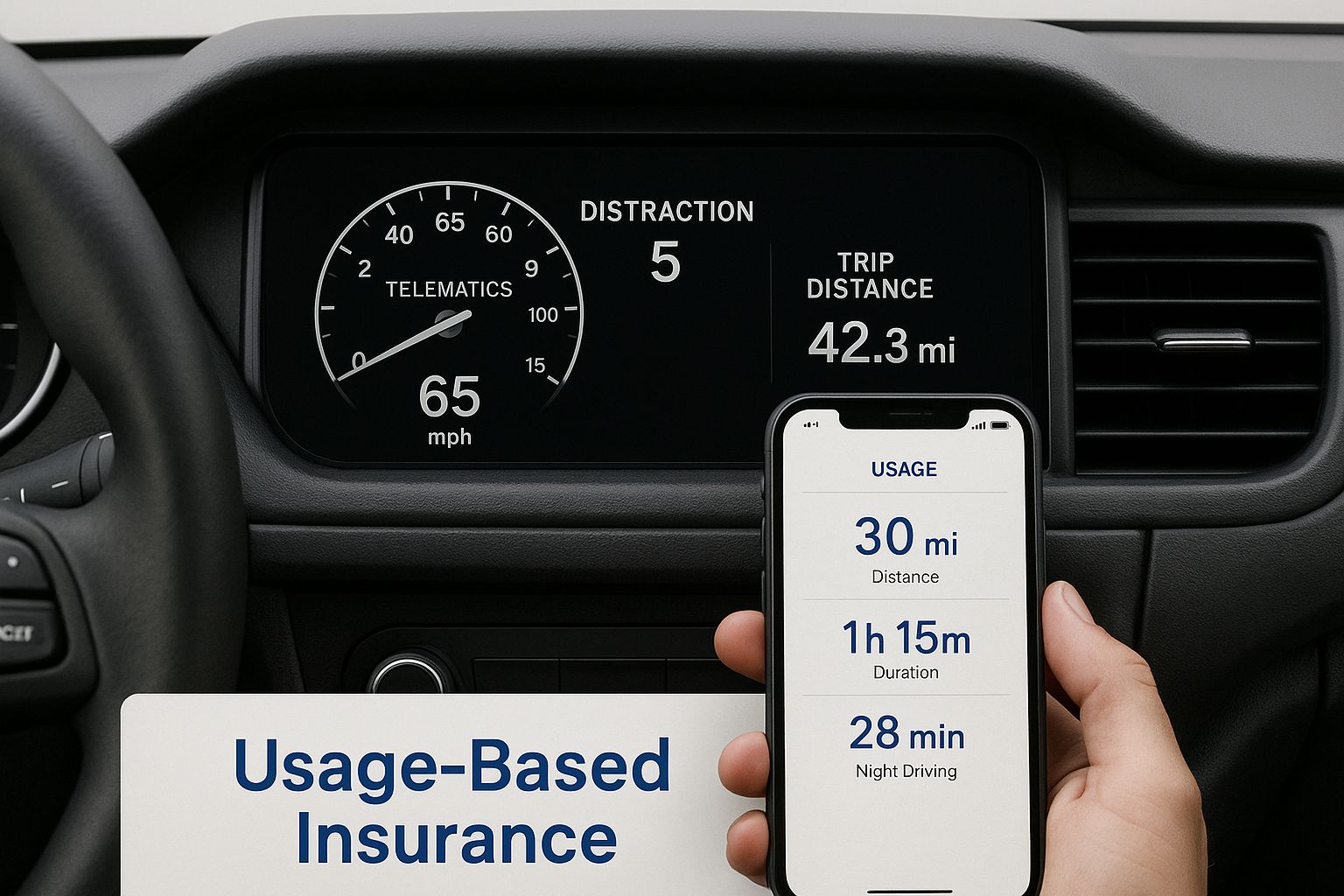For years, the insurance industry felt stuck in the past, with mountains of paperwork, slow manual processes, and policies that didn't always fit the customer. Insurtech solutions are changing all of that. Think of them as the engine modernizing insurance, swapping out old, clunky systems for smart, data-driven operations. By using tools like artificial intelligence (AI) and big data, these platforms create personalized policies, speed up claims, and make the entire customer experience feel less like a chore.
What Are Insurtech Solutions

Remember the days of renting movies from a physical store versus streaming them on demand? That’s the kind of jump we're talking about with insurtech. It’s a fundamental shift from rigid, one-size-fits-all policies to an experience that’s personal, convenient, and built on data. At its heart, insurtech isn’t just about shiny new tech; it’s a whole new way of looking at risk.
The insurance world has long been bogged down by legacy systems. This led to frustratingly slow claims, complicated pricing, and a relationship with customers that often felt distant and impersonal. Insurtech tackles these headaches head-on by weaving modern digital tools into every part of the insurance journey, from getting a quote to filing a claim. The goal is to make insurance intuitive and in sync with what we’ve come to expect from every other service in our lives.
A New Model for Insurance
The real power of insurtech lies in its ability to make insurance smarter and more responsive. Instead of just relying on historical data and broad demographic groups to set prices, these platforms can crunch massive amounts of data in real-time. This means risk can be assessed far more accurately, leading to pricing that truly reflects an individual's behaviour and needs.
This change is a huge piece of the larger digital transformation in the insurance industry, where old-school methods are finally giving way to agile, customer-first systems. The objectives are simple but powerful:
-
Boost Operational Efficiency: Automating tedious tasks like data entry, policy management, and the first steps of a claim frees up human agents to handle the more complex, human-centric parts of their job.
-
Elevate the Customer Experience: Self-service portals, mobile apps, and instant communication make dealing with an insurer as easy as ordering a pizza or booking a ride.
-
Sharpen Risk Management: Advanced analytics help insurers spot potential fraud, anticipate large-scale risks like floods or wildfires, and build more stable business models for the long run.
At its core, insurtech is about closing the gap between what customers expect and what traditional insurance can deliver. It rebuilds the process around the user, creating a more transparent, fair, and engaging relationship.
Ultimately, these solutions do more than just slap a digital coat of paint on old processes. They fundamentally redesign insurance to be proactive, not just reactive. By gathering and making sense of data, insurtech can help prevent losses before they even happen. That’s a whole new level of value for both the policyholder and the provider, and it's what truly sets this new approach apart.
The Core Technologies Driving Insurtech
If you think of modern insurance as a high-performance vehicle, then a handful of key technologies are the engine making it all run. These components work together to process information and handle tasks automatically, creating an insurance system that’s faster, smarter, and more in tune with customer needs. Getting a handle on these technologies is the first step to understanding what makes insurtech tick.
Each piece of the puzzle plays a specific part, almost like specialists on an expert team. You’ve got the analytical "brains," the data-gathering "senses," and the secure "record-keeper." Together, they build a cohesive and intelligent insurance ecosystem.
Let's break down the most essential players.
Artificial Intelligence and Machine Learning
Think of Artificial Intelligence (AI) and Machine Learning (ML) as the brains of the entire operation. These systems are incredibly good at spotting patterns in huge amounts of data, which makes them perfect for complex analysis and prediction. For example, instead of an underwriter manually combing through hundreds of data points, an AI algorithm can do it in seconds.
This ability allows insurers to assess risk with much greater accuracy, leading to fairer, more personalized pricing. AI is also a game-changer for fraud detection, as it can instantly flag suspicious claims that don't fit established patterns. And the best part? These systems "learn" as they go, becoming even more precise over time. For more information, you can explore our guide on how AI in insurance is transforming the industry.
Internet of Things
The Internet of Things (IoT) acts as the sensory system for insurtech, gathering real-time data from the physical world. IoT devices are everyday objects, from cars to thermostats, that have sensors embedded in them to connect to the internet and transmit information. This creates a direct link between what a policyholder does and their actual risk profile.
A few common examples in insurance really bring this to life:
-
Telematics Devices: These are the small sensors in cars that track driving habits, including speed, braking, and mileage. It's the technology behind usage-based auto insurance.
-
Smart Home Sensors: Think of devices that detect water leaks, smoke, or a break-in. They help prevent claims before they even happen.
-
Wearable Technology: Fitness trackers and smartwatches provide data for health and life insurance, often rewarding people for maintaining a healthy lifestyle.
Core technologies like telematics solutions in insurance are key to providing the real-time data needed for this kind of dynamic risk assessment. This constant flow of information allows insurers to be proactive about managing risk, not just reactive when a claim is filed.
This infographic shows how telematics data from a vehicle can be used for a usage-based insurance model, offering personalized metrics.

As you can see, there's a direct connection between a driver's behaviour, the data captured by IoT devices, and how an insurer might price a policy dynamically.
Blockchain and Cloud Computing
If AI is the brain and IoT provides the senses, then Blockchain is the unchangeable record book that ensures everything is transparent and trustworthy. It creates a secure, decentralized log of transactions that, once written, cannot be altered. In the insurance world, this is incredibly useful for managing complex claims or powering smart contracts, where payments are automatically released once specific conditions are met.
Finally, none of this would be possible without Cloud Computing. It's the essential backbone that supports everything else. The cloud provides the scalable, on-demand computing power required to store and process the massive datasets that AI and IoT generate. Without it, the cost and complexity of building and maintaining the necessary IT infrastructure would be a major roadblock for most companies.
It's important to remember these technologies don't work in isolation. An IoT sensor collects data, the cloud stores it, and an AI algorithm analyses it to make a decision which might then be recorded securely on a blockchain. This synergy is what gives modern insurtech solutions their power.
The combination of these tools is fuelling some serious market growth. The US insurtech market, for instance, is projected to grow at a CAGR as high as 14.5% through 2032. Digital-first approaches are completely reshaping the customer experience, making it easier than ever to get customized products.
How Insurtech Solutions Create Value

You can always tell when a new technology is truly making a difference by the real, tangible value it creates. For insurtech solutions, this isn't just about a minor tweak to an old system; it's about fundamentally improving the insurance experience for everyone involved, from the carriers managing risk to the people seeking protection.
Ultimately, this shift turns insurance from a static, reactive product into something dynamic and proactive.
This creates a powerful win-win. Insurance providers operate more efficiently and profitably, while their customers get a fairer, faster, and more intuitive service. It’s all about building a smarter, more responsive insurance ecosystem where technology helps both sides of the equation.
For Insurance Providers, Better Operations and Sharper Insights
Insurance companies adopting insurtech see the benefits ripple through every corner of their business. The most immediate impact usually comes from automation, which takes over the repetitive, manual tasks that used to eat up countless hours. This frees up talented people to focus on what they do best: solving complex problems and building stronger customer relationships.
But it goes much deeper than just simple automation. These platforms offer a much sharper view of risk. By analyzing massive datasets, insurers can finally move beyond broad, generic categories and price their policies with incredible precision. This data-driven approach means more accurate underwriting, a lower chance of mispriced risk, and a healthier, more stable portfolio in the long run.
Here are some of the key advantages for providers:
-
Smoother Operations: Automating policy administration, initial claims processing, and data entry slashes overhead and cuts down on human error.
-
Smarter Risk Assessment: AI and data analytics enable a much more granular evaluation of risk, leading to more competitive and sustainable pricing.
-
Reduced Fraud: Advanced algorithms can spot suspicious patterns in claims data that a person would almost certainly miss, saving the industry billions.
This isn't just a niche trend; it's happening on a massive scale. California is a perfect example. As a key player in the North American insurtech market, which held over 36.0% of global revenue in 2022, its carriers have leaned heavily into cloud computing. The cloud captured over 24% of the market share as insurers raced to modernize their infrastructure and get a handle on costs. You can read more about the insurtech market landscape to see how these trends are taking shape.
For Customers, a Fairer and Faster Experience
On the other side of the counter, customers are seeing a dramatic improvement in how they interact with insurance. The days of confusing paperwork, long waits, and one-size-fits-all policies are quickly becoming a thing of the past. Insurtech puts the user front and centre.
Perhaps the biggest win for customers is the move toward personalization. Instead of a generic policy, you can now get coverage that actually reflects your lifestyle and behaviour. A safe driver can earn a lower auto premium, or a homeowner with a smart security system can get a discount. It just makes sense.
The core value for customers is simple: clarity, speed, and fairness. Insurtech solutions demystify the insurance process, making it transparent and aligning the cost of coverage directly with an individual's actual risk.
This customer-first approach completely changes the claims process, too. What was once a slow, often frustrating ordeal is now remarkably efficient. A policyholder can use a mobile app to submit a claim with photos and details in just a few minutes. In many cases, they can get a settlement in a fraction of the time it used to take. That kind of speed and transparency builds trust and goes a long way toward creating loyal customers.
Traditional Insurance vs. Insurtech Solutions: A Comparison
To really see the difference, it helps to put the old and new ways side-by-side. The following table breaks down how insurtech is completely overhauling legacy processes, making them faster, smarter, and more customer-friendly.
|
Process |
Traditional Approach |
Insurtech Solution |
|---|---|---|
|
Policy Quoting |
Long forms, phone calls, and reliance on broad demographic data. |
Instant online quotes, mobile apps, personalized pricing with AI. |
|
Underwriting |
Manual review of documents often takes days or weeks. |
Automated data analysis, real-time risk assessment, faster approvals. |
|
Policy Management |
Paper-based documents, changes require calling an agent. |
Digital dashboards, self-service policy changes via an app or portal. |
|
Claims Filing |
Lengthy paperwork, in-person assessments, and slow processing. |
Mobile app submissions with photos/videos, AI-driven damage assessment. |
|
Fraud Detection |
Manual reviews by investigators rely on human intuition. |
AI algorithms that analyze data to flag suspicious patterns instantly. |
|
Customer Service |
Call centres with long wait times, limited business hours. |
24/7 AI-powered chatbots, proactive communication, personalized support. |
As you can see, the contrast is stark. Insurtech isn't just digitizing old methods; it's rethinking them from the ground up to deliver a fundamentally better experience for everyone.
Insurtech Solutions in the Real World
It's one thing to talk about the theory, but seeing insurtech solutions in action is where you really grasp their impact. Across the insurance world, these technologies aren't just buzzwords; they're solving real, nagging problems that have existed for decades. Each use case tells a story of a shift away from a slow, one-size-fits-all model toward something more immediate and personal.
This isn’t science fiction. It’s happening right now, completely changing how insurers and policyholders interact. From the car in your driveway to the roof over your head, insurtech is making insurance smarter and more in tune with your actual life.
Let's look at a few powerful examples of how this is playing out.
Rewarding Safer Drivers in Auto Insurance
For years, your car insurance premium was calculated using broad strokes: your age, your driving record, and the car you own. This often meant a cautious driver who barely uses their car could end up paying similar rates to someone far riskier in the same demographic. Insurtech, specifically telematics, has flipped that script.
Telematics uses a simple app or a small plug-in device in your car to gather real-time data on how you actually drive. It looks at things like:
-
Speed and Acceleration: Are you driving aggressively or smoothly?
-
Braking Patterns: Frequent hard braking can signal a higher risk.
-
Time of Day: It matters whether you’re driving at 2 PM on a Tuesday or 2 AM on a Saturday.
-
Mileage: If you drive less, you should pay less. Simple as that.
All this data fuels a model called usage-based insurance (UBI), where your premium is directly linked to your driving habits. The idea is brilliant in its simplicity: drive safer, pay less. Not only does this feel fairer to the customer, but it also actively encourages better driving, which can lead to fewer accidents on the road.
We're moving from assumption-based pricing to evidence-based pricing. The insurer is no longer just guessing your risk level; they're measuring it. This creates a much more transparent and honest relationship.
Personalizing Health and Wellness Plans
The health insurance space is also being shaken up, thanks largely to the wearable tech on our wrists. With 73% of adults now using devices like smartwatches and fitness trackers daily, there's a constant stream of valuable wellness data available. Insurtech platforms are tapping into this to build health and life insurance plans that are truly personal.
Instead of basing everything on a single medical exam from years ago, insurers can now encourage and reward you for staying healthy. For instance, you might earn points or even get a discount on your premium for hitting a daily step count, keeping your heart rate in a healthy zone, or taking part in a wellness challenge.
It’s a win-win. Policyholders get a real incentive to lead healthier lives, which naturally reduces their long-term health risks. For the insurer, a healthier customer base means fewer claims and a more stable, sustainable business.
Accelerating Property Claims with Drones and AI
Think about the aftermath of a hurricane or wildfire. Assessing property damage used to be a painfully slow, dangerous, and manual job. Adjusters had to travel into disaster zones, climb on damaged roofs, and slowly compile reports. This could take weeks, leaving homeowners stuck in limbo.
Insurtech has completely changed this workflow.
-
Rapid Data Collection: Drones with high-resolution cameras can be in the air almost immediately after an event. They capture incredibly detailed images and video of damaged properties without putting a single person at risk.
-
AI-Powered Analysis: This flood of visual data is then fed into an AI platform. The system can instantly analyze the extent of the damage, identifying everything from missing shingles to major structural failures with stunning accuracy.
-
Faster Payouts: With a clear, objective damage report ready in hours instead of weeks, insurers can process the claim and get money into the hands of their policyholders when they need it most.
This is just one example. Real-world applications of insurtech solutions range from these complex analytics platforms to specialized tools like insurance-specific answering services that ensure a policyholder can always reach someone during a crisis.
Streamlining Life Insurance Underwriting
Applying for life insurance has traditionally been a drawn-out headache. It often involved a full medical exam, blood work, and stacks of paperwork, creating a huge hurdle that stopped many people from getting the coverage they needed. Today, data analytics and AI are making it possible to sidestep that entire process.
By securely analyzing a mix of data points, like prescription history, public records, and motor vehicle reports, powerful algorithms can build a complete risk profile in a matter of minutes. This accelerated underwriting allows insurers to approve policies for healthy applicants almost on the spot. It's faster, far less intrusive, and opens the door for more people to get vital financial protection for their families.
Navigating the Hurdles of Insurtech Implementation
Bringing new technology into any business is a big undertaking, and insurance is no exception. While the promise of insurtech is huge, the path to getting there is often littered with obstacles. It's not just a simple plug-and-play scenario. Success means anticipating these challenges and having a solid plan to tackle them head-on.
The biggest roadblocks aren't always technical. They're often tied to people, old ways of doing things, and navigating a maze of regulations. From getting new platforms to talk to decades-old systems to keeping sensitive customer data safe, every step demands careful thought and execution.
The Legacy Systems Anchor
For many established insurance companies, one of the biggest headaches is the tangle of outdated legacy systems. We're talking about core systems built before 2010, long before anyone imagined the cloud-based, hyper-connected tools we have today. It’s like trying to run a modern navigation app on an old flip phone; they just don't speak the same language.
This disconnect causes a whole host of problems. It creates data silos, so you can't get a single, clear view of your customer. It also leads to clunky manual workarounds that kill productivity. The effort to untangle this mess can be staggering, often requiring massive financial investments and complex projects that span several years.
Even with the U.S. insurtech market, where California is a major innovation hub, valued at roughly USD 50.2 billion in 2025 and expected to hit USD 67.36 billion by 2030, this issue persists. Modernization projects can easily top USD 200 million, pushing back the return on investment. To get around this, many California-based insurtechs are using API-driven microservices to build bridges to these older systems, which allows for a much smoother, more gradual transition. You can discover more about the US insurtech market dynamics to see how these trends are playing out.
Data Privacy and Regulatory Hurdles
Insurtech runs on data. But with great data comes great responsibility. Regulations like the California Consumer Privacy Act (CCPA) lay down strict rules on how personal information can be handled, and compliance is absolutely mandatory. A single data breach can lead to crippling fines and, even worse, destroy customer trust.
Protecting this data has to be the top priority. Companies need to build fortress-like security to defend against cyber threats. For a deeper look at this critical topic, our guide on cybersecurity in the insurance industry is a must-read.
But it’s not just about security. Insurers also have to navigate a complex web of regulations that can change from one region to the next. Proving that your new AI underwriting model isn't biased or that your digital product meets all legal standards requires constant attention and real regulatory expertise.
The real trick is to balance innovation with compliance. Insurers have to find creative ways to use data to improve the customer experience without ever crossing the line on privacy or breaking the rules. It's a delicate balancing act that demands a security-first culture.
Overcoming Cultural Resistance
The human side of change is often the most overlooked and the most difficult challenge. The insurance industry is built on tradition and stability, so it's natural for people to be skeptical of new ways of working. Employees who are masters of the old processes might resist new tools, worried that their jobs are on the line.
Getting insurtech right is about more than just installing software; it’s about changing the company's culture. Here’s how to make that happen:
-
Be Clear About the "Why": Leadership needs to clearly explain why the change is happening and how it will make things better for everyone, from the company as a whole to individual team members.
-
Invest in Training: You can't just hand people a new tool and expect them to run with it. Proper, hands-on training and continuous support are crucial for building confidence and making sure everyone can use the new systems well.
-
Get People Involved: When you include your teams in the process of choosing and implementing new tech, they feel a sense of ownership. This can turn your biggest skeptics into your most passionate advocates.
What's Next for Insurtech?
Looking ahead, the evolution of insurtech is about to kick into high gear. We're moving past just making old processes faster and are now on the verge of completely changing how we think about and interact with risk. The next wave isn't just about automation; it's about deep personalization and proactive support, turning insurance from a grudge purchase into a genuine partner in our daily lives.
This isn't some far-off sci-fi concept; the groundwork is already being laid. We're shifting away from static, one-size-fits-all policies toward dynamic coverage that actually adapts to what we do and how we live. This promises an insurance experience that’s not only easier but also fairer and more in tune with our individual needs.
Hyper-Personalization and Embedded Coverage are Taking Centre Stage
One of the most exciting developments is hyper-personalization, where your policy can literally change based on your actions. Think about your car insurance premium getting a tiny discount after a week of safe driving, tracked by your phone's telematics. Or imagine your home insurance rate adjusting the moment you install a new smart alarm system. This kind of real-time responsiveness is powered by data from IoT devices, creating a policy that truly lives and breathes with you.
At the same time, we're seeing a huge rise in embedded insurance. This is all about making coverage an invisible, seamless part of another purchase. You buy a flight, and travel insurance is offered right there at the checkout. You get a new laptop, and the option to protect it is just a single click away.
This strategy is brilliant because it meets people exactly where they are, offering the right protection at the precise moment they need it. It cuts out the hassle of having to go find an insurance company, making protection feel like a natural part of the buying process.
Generative AI Will Add a Human Touch
Artificial intelligence is also getting a major upgrade. While the AI we've used so far has been great for crunching numbers and spotting patterns, generative AI is set to completely change how insurers talk to their customers. It can power chatbots that provide surprisingly empathetic and clear guidance during a stressful claims process or explain confusing policy jargon in plain English.
This technology makes it possible to offer high-quality, personal-feeling service at a massive scale. The trick will be to blend the efficiency of AI with a genuinely helpful, human tone, making sure people feel heard and supported 24/7.
Ultimately, the future of insurtech is about more than just slick apps and algorithms. It’s a fundamental mindset shift moving from a reactive model that just pays out after something goes wrong to a proactive partnership that helps prevent problems in the first place. This gives people and businesses the power to be better protected with coverage that is intelligent, integrated, and intensely personal.
Your Insurtech Questions, Answered
Even after getting the basics down, you probably still have a few questions swirling around about how insurtech actually works in practice. Let's tackle some of the most common ones to clear things up.
What’s the Real Difference Between Insurtech and Traditional Insurance?
The biggest split comes down to their core philosophy and how they operate. Traditional insurance was built on a foundation of standardized products, mountains of paperwork, and interactions that mostly happened through an agent. It's a system that looks at the past, using historical data to sort people into broad risk categories.
Insurtech flips that model on its head. It uses technology to put you, the customer, right at the centre of everything. The focus shifts to creating a personalized experience that’s fast, simple, and transparent. It's less like buying an off-the-rack suit and more like getting one custom-fit to your lifestyle and habits.
How Does Insurtech Actually Make Insurance Cheaper?
It really boils down to two things: running a much leaner operation and getting way smarter about risk.
-
Smarter Operations: Think about all the administrative legwork in traditional insurance underwriting, managing policies, and handling the first steps of a claim. Insurtech automates a huge chunk of that. Fewer manual tasks mean lower overhead costs for the insurer.
-
Pinpoint Risk Assessment: Instead of just looking at general statistics, insurtech platforms can analyze massive streams of real-time data. This allows them to price risk with incredible accuracy, offering better premiums to lower-risk customers and pricing higher-risk policies more fairly. A more precise system means a more stable, balanced market for everyone.
At its heart, the logic is straightforward: when you run a more efficient business and understand risk better, you can pass those savings directly to your customers. This makes the whole market more competitive, and good behaviour often gets rewarded with lower prices.
Is My Personal Data Safe with These Companies?
For any credible insurtech company, data security isn't just a feature; it's the foundation of their business. Their entire model is built on trust and data, so protecting your information is non-negotiable.
You'll find that insurtech platforms use multiple layers of security to keep customer information locked down. This usually includes:
-
Advanced Encryption: Scrambling your data so it’s unreadable, both when it's being stored and when it's moving between systems.
-
Strict Access Controls: Making sure only the right people can see sensitive information, and only when they absolutely need to.
-
Regulatory Compliance: Following strict data protection laws, like Canada’s Personal Information Protection and Electronic Documents Act (PIPEDA).
These companies pour significant resources into cybersecurity to stay ahead of threats. While no digital system is ever 100% bulletproof, the security standards in the insurtech world are incredibly high and are constantly being updated to deal with new risks.
Ready to modernize your operations with custom software? Cleffex Digital Ltd builds innovative technology solutions to solve your biggest business challenges. Visit our website at https://www.cleffex.com to learn how we can help you grow.








